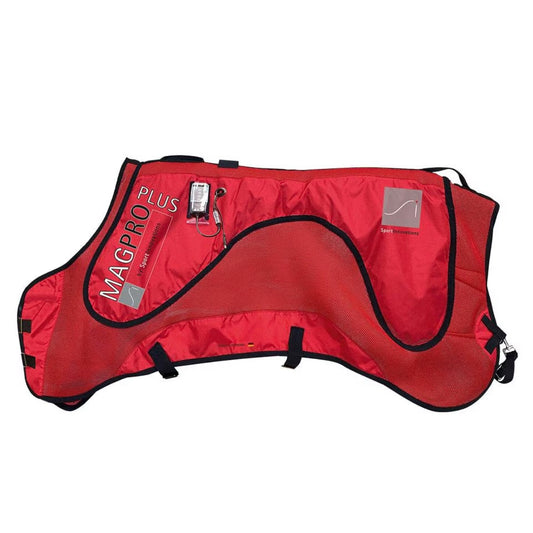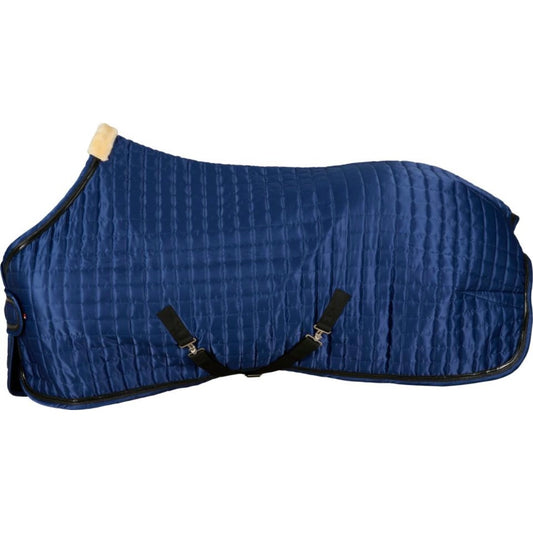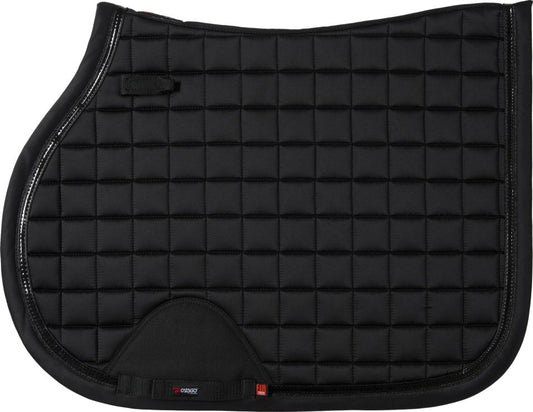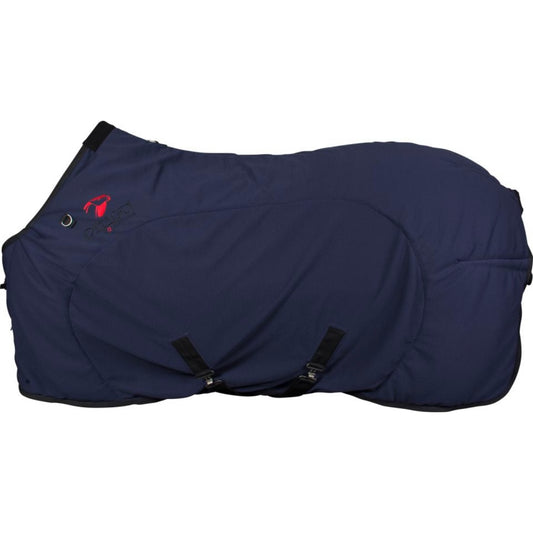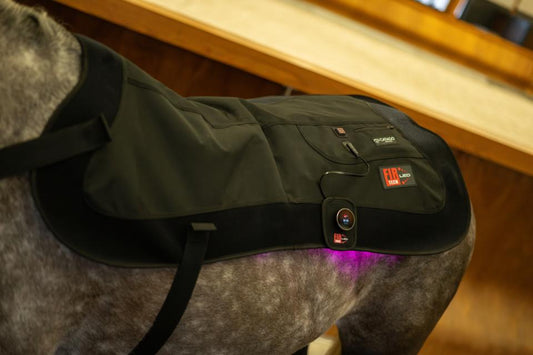Back Injuries
Back Strain
Back strain in horses refers to the overstretching or overloading of muscles, ligaments, or tendons in the back region. This injury can lead to pain, muscle stiffness, decreased performance, and, if untreated, long-term mobility issues. While horses of all ages can suffer from back strain, it is especially common in performance horses such as those involved in dressage, jumping, and racing.
Causes of Back Strain in Horses
Back strain can result from various factors, including:
- Improper Training Techniques: Sudden increases in exercise intensity, improper training methods, or overloading the horse without sufficient conditioning can lead to muscle strain.
- Incorrect Saddle Fit: A poorly fitting saddle—whether too tight, too loose, or misaligned—can cause pressure points and discomfort, contributing to muscle strain.
- Conformation and Posture Issues: Horses with weak or imbalanced musculature, particularly in the back or hindquarters, are more prone to strain. Poor posture, either from improper movement or inability to carry weight properly, can also cause injury.
- Overexertion: Overworking horses without adequate rest can lead to muscle strain, especially in those involved in intense physical activities like jumping or racing.
- Trauma or Impact: Falls, kicks, or direct trauma to the back (including impacts from rough terrain) can result in back strain.
- Age-Related Factors: Older horses or those with pre-existing conditions, such as arthritis or spinal issues, are more vulnerable to back strain due to degenerative changes in the back and supporting structures.
How to Prevent Back Strain in Horses
Prevention focuses on good management practices, proper conditioning, and ensuring the horse’s comfort during exercise. Key prevention strategies include:
- Proper Saddle Fit: Ensure that your horse’s saddle fits properly to prevent pressure points and reduce strain on the back muscles. Consult a professional saddle fitter to confirm a good fit.
- Balanced Training and Exercise Regimen: Gradually increase the intensity and duration of training to avoid overloading the back muscles. Include warm-up and cool-down routines, and vary exercise intensity to allow muscle recovery.
- Strengthening and Conditioning: Focus on strengthening the back and core muscles through specific exercises, and incorporate stretching to improve flexibility and support for the back.
- Correct Rider Position and Technique: Riders should maintain good posture and avoid placing undue pressure on the horse’s back, which could contribute to strain.
- Provide Adequate Rest: Allow your horse sufficient recovery time between intense workouts to avoid overuse injuries.
- Avoidance of Trauma: Monitor your horse for signs of discomfort or unusual behavior indicating trauma and address any issues promptly to prevent further injury.
What to Do if Your Horse Develops Back Strain
If your horse shows signs of back strain, immediate action is necessary to manage the condition and prevent further injury:
- Rest and Box Rest: Allow your horse to rest in a comfortable stall or paddock. Box rest may be needed in more severe cases to prevent the horse from using the affected muscles.
- Pain Relief and Anti-Inflammatories: Consult a veterinarian for pain management strategies. Non-steroidal anti-inflammatory drugs (NSAIDs) may be prescribed to reduce pain and inflammation.
- Cold Therapy (Cooling): Apply cold therapy (ice packs or cold compresses) to the affected area within the first 48 hours to reduce swelling and inflammation.
- Monitor for Symptoms: Watch for worsening symptoms such as reluctance to move, stiffness, or behavior changes. If symptoms persist or worsen, contact a veterinarian.
- Gentle Stretching and Massage: Once acute inflammation subsides, gentle stretching and massage can help relax tight muscles and promote circulation for healing.
- Gradual Return to Work: Gradually reintroduce your horse to work, starting with light exercises and increasing intensity slowly to avoid reinjury.
Therapies for Treating Back Strain in Horses
Several therapies can aid in recovery, reducing pain, inflammation, and promoting faster healing:
- Vibration Therapy: Stimulates circulation, reduces muscle tension, and promotes soft tissue healing by increasing blood flow to the affected area.
- PEMF Therapy: Pulsed Electromagnetic Field (PEMF) therapy reduces pain and inflammation, stimulates cellular repair, and enhances circulation to promote muscle regeneration.
- NMES Therapy: Neuromuscular Electrical Stimulation (NMES) promotes muscle healing by stimulating the muscles, reducing stiffness, and improving muscle tone.
- LED Therapy: Uses light energy to promote cellular activity, accelerate tissue repair, and reduce inflammation in the affected area.
- Infrared Therapy: Penetrates deeper tissues to reduce inflammation and improve blood flow, supporting deep tissue healing and muscle relaxation.
- Cooling Therapy: Cold packs or ice during the initial stages of injury can reduce inflammation, numb the area for pain relief, and prevent further damage.
Conclusion
Back strain is a common yet preventable injury in horses caused by overexertion, improper saddle fit, poor posture, or trauma. Prevention strategies such as proper training, correct saddle fitting, and adequate rest are essential in reducing the risk. If back strain occurs, immediate treatment—including rest, cold therapy, and gentle massage—can aid in recovery. Therapies like vibration therapy, PEMF, NMES, LED, and infrared therapy are effective tools in promoting healing and reducing inflammation, helping your horse recover faster and return to work. Always consult a veterinarian for the best treatment and care for your horse's condition.
Saddle Fit Issues Leading to Back Pain
Saddle fit is crucial for a horse's comfort and performance. A poorly fitting saddle can cause various physical problems, with back pain being one of the most common and concerning. When a saddle does not fit properly, it can create pressure points, restrict movement, and lead to muscle strain, ultimately causing discomfort and affecting the horse's performance, behavior, and overall health.
Causes of Saddle Fit Issues Leading to Back Pain
Several factors can contribute to saddle fit issues and resulting back pain in horses:
- Improper Saddle Shape and Size: Saddles that are too narrow or too wide for the horse's back cause uneven pressure distribution. A narrow saddle digs into the horse's spine and shoulders, while a wide saddle sits too far back, creating pressure on the lumbar region.
- Inadequate Gullet Width: The gullet, the space between the saddle panels over the withers and spine, can cause discomfort if it’s too narrow, pinching the withers and spine. If too wide, the saddle can sit too low on the back, leading to imbalance and pressure points.
- Saddle Pad Issues: An ill-fitting or worn-out saddle pad can exacerbate saddle fit problems. Pads that are too thick, thin, or uneven create additional pressure points or fail to provide adequate support, leading to muscle strain and back pain.
- Changes in the Horse's Body Shape: As horses mature or undergo changes in weight, muscle development, or coat/condition changes, their bodies can affect the saddle fit. Young or growing horses are particularly susceptible to these changes.
- Saddle Positioning: The saddle's position on the horse's back can cause issues. A saddle placed too far forward or too far back can interfere with natural movement, causing compensatory strains in the back muscles.
- Rider Position and Technique: Sometimes, the rider’s posture or technique can affect saddle fit. A rider who leans forward or uses uneven pressure on the reins can shift the saddle’s position, increasing pressure on specific areas of the back.
How to Prevent Saddle Fit Issues Leading to Back Pain
Preventing saddle fit problems and back pain involves a combination of proper saddle fitting, regular checks, and maintaining awareness of the horse's condition:
- Regular Saddle Fitting: Have your horse’s saddle professionally fitted, especially if its body shape changes. Reassess saddle fit after any significant changes in the horse’s weight, muscle tone, or training intensity.
- Proper Saddle Pad Use: Use a well-fitting saddle pad that complements the saddle and fits the horse's back correctly. It should provide even pressure distribution without creating pressure points.
- Check for Signs of Discomfort: Be observant for signs of discomfort, such as reluctance to work, resistance to certain movements, or unusual behavior during saddling. If discomfort is observed, reassess the saddle fit immediately.
- Horse Conditioning: Regular fitness and conditioning programs help maintain muscle tone, supporting the saddle fit. A well-conditioned horse will handle saddle pressure more efficiently and move freely.
- Monitor Changes in the Horse’s Shape: Keep track of your horse’s physical changes. Significant changes in shape, weight, or muscle development may require a new saddle fitting.
- Proper Riding Technique: Riders should maintain a balanced posture and avoid leaning forward or uneven pressure that can shift the saddle, exacerbating fit issues and creating uneven pressure.
What to Do if Your Horse Has Back Pain Due to Saddle Fit Issues
If you suspect that your horse is experiencing back pain due to saddle fit, it's essential to take immediate action to alleviate discomfort and prevent further injury. Follow these steps:
- Remove the Saddle: Immediately remove the saddle to prevent further irritation and pressure on the back. Gently inspect the back area for any abrasions or injuries.
- Rest and Box Rest: If the pain is significant, rest and box rest may be necessary. Limit movement to avoid exacerbating the condition and allow time for healing.
- Cold Therapy: Apply cold therapy (cold compress or ice packs) to the affected areas, especially within the first 48 hours, to reduce swelling and inflammation.
- Assess Saddle Fit: Have a professional saddle fitter assess the saddle and its fit. This may involve adjusting the saddle or purchasing a new one that better suits your horse's body shape.
- Veterinary Consultation: Consult a veterinarian to rule out other causes of back pain and receive a professional diagnosis. In some cases, diagnostic imaging like X-rays may be recommended to detect underlying damage or inflammation.
- Gentle Movement: Once acute pain subsides, encourage gentle movement to prevent stiffness and promote circulation for healing. Start with light walks and gradually increase activity.
Therapies to Improve Recovery from Saddle Fit-Related Back Pain
Several therapies can help alleviate back pain caused by saddle fit issues and promote recovery:
- PEMF Therapy: Pulsed Electromagnetic Field (PEMF) therapy reduces inflammation, stimulates blood flow, and encourages tissue repair. It’s particularly effective for soft tissue injuries and accelerates healing.
- Vibration Therapy: Vibration therapy stimulates circulation and helps relax muscles, reducing stiffness and promoting muscle healing in the back.
- NMES Therapy: Neuromuscular Electrical Stimulation (NMES) helps with muscle rehabilitation and strengthening, beneficial for weak or imbalanced back muscles caused by saddle fit issues.
- LED Therapy: LED therapy uses light energy to stimulate cell regeneration, increase tissue oxygenation, and reduce pain and inflammation in the affected area.
- Infrared Therapy: Infrared therapy aids deep tissue healing, increasing blood flow and relaxing muscles to relieve pain and inflammation associated with saddle fit issues.
- Cooling Therapy: Cooling therapy (cold packs or ice wraps) is particularly effective in the acute phase, reducing swelling and pain while preventing further damage to tissues.
- Massage and Stretching: Gentle massage helps relax the back muscles and improve circulation. Stretching exercises, once pain subsides, can increase flexibility and prevent stiffness.
Conclusion
Saddle fit issues are a common cause of back pain in horses, leading to discomfort, muscle strain, and even behavioral changes. Regular saddle fitting, proper conditioning, and awareness of the horse's condition are essential to prevent saddle fit problems. If your horse experiences back pain due to saddle fit, immediate steps such as rest, cold therapy, and a professional saddle fit assessment are crucial. Therapies like PEMF, vibration therapy, NMES, LED, and infrared therapy can greatly aid in recovery, reducing pain, inflammation, and promoting muscle healing. Always consult with your veterinarian and a qualified saddle fitter to ensure optimal care for your horse.
Kissing Spine Syndrome
Kissing Spine Syndrome (KSS) is a condition in horses where the spinous processes (the bony projections along the spine) come into contact or even press against each other. This contact can lead to pain, inflammation, and potential damage to the surrounding tissues. Over time, it can result in significant discomfort, reduced performance, and behavioral changes in the horse.
Causes of Kissing Spine Syndrome
Several factors contribute to the development of Kissing Spine Syndrome in horses:
- Congenital Factors: Some horses are born with anatomical predispositions, where the spinous processes are closer together than normal.
- Improper Saddle Fit: One of the most common acquired causes of KSS. A poorly fitting saddle can exert excessive pressure on the back, leading to vertebral misalignment and contact between the spinous processes.
- Muscle Imbalances or Weakness: Horses with weak back muscles, muscle imbalances, or poor posture are more prone to developing KSS. These issues put extra stress on the spine, promoting contact between the spinous processes.
- Overloading or Poor Conditioning: Excessive or intense exercise without proper conditioning can overload the spine, causing contact between the spinous processes.
- Trauma or Injury: Direct injury to the back (e.g., falls or impacts) can cause structural changes in the spine, contributing to the development of KSS.
- Age and Wear: As horses age, wear and tear on the spine and changes in posture and gait can lead to misalignment and the development of KSS, especially in older horses undergoing intensive training.
How to Prevent Kissing Spine Syndrome
While not all cases of Kissing Spine Syndrome can be prevented, there are several ways to reduce the risk:
- Proper Saddle Fit: Ensure your horse’s saddle fits properly and does not press on the spine or withers. Regularly check saddle fit and consult a professional fitter if your horse shows signs of discomfort during saddling or riding.
- Strengthen Core Muscles: Targeted exercises to build the horse's core and back muscles can help support the spine, reduce misalignments, and prevent excessive strain on the back.
- Gradual Increase in Training Intensity: Avoid sudden increases in exercise intensity. Gradual conditioning programs allow muscles and joints to adapt, reducing the risk of overloading the back.
- Avoid Trauma: Minimize the risk of falls or injuries by training in safe environments and avoiding unnecessary risks.
- Frequent Veterinary Checkups: Regular veterinary checkups, including spinal assessments, can help detect early signs of Kissing Spine Syndrome and allow for early intervention.
What to Do if Your Horse Has Kissing Spine Syndrome
If your horse is diagnosed with Kissing Spine Syndrome, early intervention and management are crucial to minimizing pain and improving quality of life. The following steps are recommended:
- Veterinary Diagnosis: Obtain a proper diagnosis from a veterinarian. Diagnosis typically involves physical exams, imaging techniques (like X-rays or ultrasound), and possibly a diagnostic nerve block.
- Box Rest: Your veterinarian may recommend box rest to allow the muscles to relax, reduce inflammation, and prevent further strain on the spine.
- Pain Management: NSAIDs may be prescribed to manage pain and inflammation. In some cases, corticosteroid injections into the affected area may provide additional relief.
- Controlled Exercise: Gradually reintroduce controlled movement, such as hand walking or light riding, after the initial rest period to strengthen the back muscles without overloading the spine.
- Postural Adjustments: Work with your veterinarian and a professional trainer to adjust the horse's posture and riding technique. Proper biomechanics are crucial for recovery and to avoid aggravating KSS.
Therapies to Improve Recovery from Kissing Spine Syndrome
Several therapies can help manage pain, promote healing, and support recovery:
- PEMF Therapy (Pulsed Electromagnetic Field): PEMF therapy is a non-invasive treatment that stimulates healing in damaged tissues, reduces inflammation, improves circulation, and promotes cellular repair.
- LED Therapy: LED therapy uses light to penetrate tissues and stimulate cell regeneration. It helps reduce inflammation, alleviate pain, and encourage tissue repair.
- Infrared Therapy: Infrared therapy increases blood flow and reduces muscle tension. The deep heat generated by infrared light can relax muscles around the spine and relieve pain.
- NMES (Neuromuscular Electrical Stimulation): NMES helps strengthen muscles surrounding the spine and improve muscle tone, reducing strain on the spine and alleviating discomfort.
- Massage and Chiropractic Care: Therapeutic massage can relax tight muscles and relieve pain associated with KSS. Chiropractic adjustments may also help realign the spine and improve mobility.
- Cold Therapy: Cold therapy (e.g., cold compresses or ice) can help reduce inflammation and swelling, especially during the acute phase of the condition.
- Shockwave Therapy: Extracorporeal Shock Wave Therapy (ESWT) uses acoustic waves to stimulate tissue healing, reduce inflammation, and improve mobility.
- Surgical Intervention: In severe cases, surgery may be required to remove or separate the affected spinous processes. Surgery is typically considered when conservative treatments do not provide sufficient relief.
Conclusion
Kissing Spine Syndrome is a painful condition that can significantly affect a horse's comfort and performance. While factors like improper saddle fit, muscle imbalances, and trauma can contribute to KSS, regular monitoring and proper care can help prevent or minimize its severity. If diagnosed, KSS can be managed through rest, pain management, and targeted therapies such as PEMF, LED, NMES, and infrared therapy. Always consult a veterinarian for an accurate diagnosis and treatment plan tailored to your horse's specific needs.



